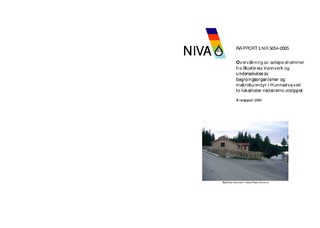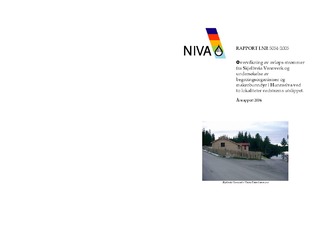| dc.contributor.author | Molvær, J. | nb_NO |
| dc.contributor.other | Molvær, J. - Project manager | nb_NO |
| dc.coverage.spatial | | nb_NO |
| dc.date.accessioned | 2014-08-01T10:49:35Z | |
| dc.date.available | 2014-08-01T10:49:35Z | |
| dc.date.issued | 2005 | nb_NO |
| dc.identifier | 5034 | nb_NO |
| dc.identifier.isbn | 82-577-4735-1 | nb_NO |
| dc.identifier.issn | 1894-7948 | nb_NO |
| dc.identifier.uri | http://hdl.handle.net/11250/212847 | |
| dc.description | Årsliste 2005 | nb_NO |
| dc.description.abstract | The nutrient load from land-based sources is dominated by municipal waste water. However, due to high water exchange the overall nutrient load originates from nearby water bodiesthrough water exchange into the area. Due to vertical stratification the plumes from the deep outfalls are usually trapped below the surface. However under weak stratification and weak current conditions, highly diluted waste water may reach the surface (especially RA2 and U1). Except for the deep water in some fjord basins with sills, the water exchange is good. In general the water quality is very good, except for oxygen condition in the basin water of Aspevaag and Mauseidvaag, and for hygienic problems at outfall U1. Flora and fauna between the surface and 30 m depth are in good conditions on most stations, but with negative effects from debris and sludge around the outfalls from RA2 and RA4. The status for soft bottom fauna is very good, except for the Aasefjord (classification: Good). Based on topography and knowledge about the water exchange, the outfalls of municipal waste water can be considered as located in three separate recipients: northern, middle and southern area. | nb_NO |
| dc.description.sponsorship | Aalesund and Sula municipalities, Møre and Romsdal | nb_NO |
| dc.publisher | Norsk institutt for vannforskning | nb_NO |
| dc.relation.ispartofseries | NIVA-rapport;5034 | nb_NO |
| dc.rights | Navngivelse-IkkeKommersiell-DelPåSammeVilkår 3.0 Norge | nb_NO |
| dc.rights.uri | http://creativecommons.org/licenses/by-nc-sa/3.0/no/ | nb_NO |
| dc.subject | oseanografi og fjernmåling | nb_NO |
| dc.title | Fjords in Aalesund and Sula municipalities. Environmental status and effects from discharges of municipal waste water, compared to the requirement of secondary treatment in the urban Waste Water Directive | nb_NO |
| dc.type | Research report | nb_NO |
| dc.rights.holder | Norsk institutt for vannforskning/Norwegian institute for water research | nb_NO |
| dc.subject.nsi | VDP::Matematikk og naturvitenskap: 400 | nb_NO |
| dc.source.pagenumber | 23 | nb_NO |
| dc.subject.keyword | avløpsdirektivet | nb_NO |
| dc.subject.keyword | kommunalt avløpsvann | nb_NO |
| dc.subject.keyword | urban waste water directive | nb_NO |
| dc.subject.keyword | municipal waste water | nb_NO |
| dc.relation.project | O-23245-7 | nb_NO |


